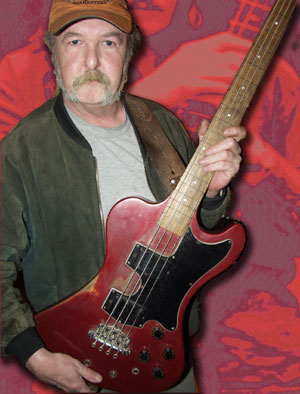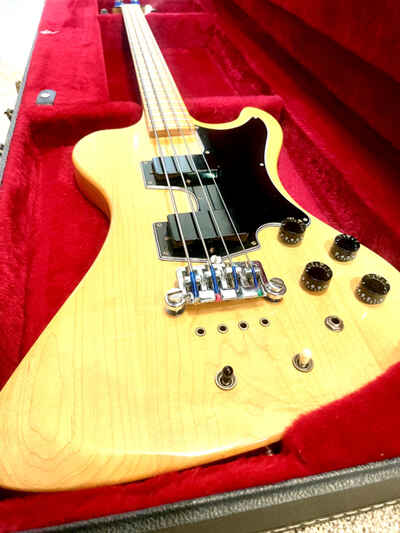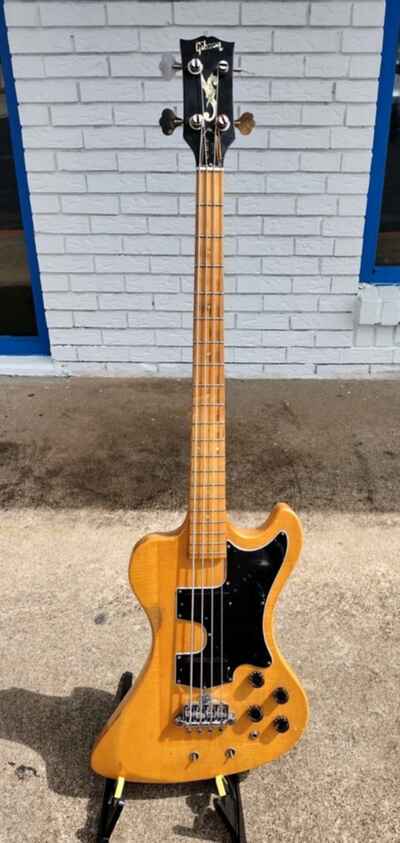Intro and the Gibson RD Artist bass
April 2009 Mick Hawksworth has been performing and recording for over 40 years, in a long line up of bands, and as a session player. In the 60s he was noted for his "technically brilliant basslines" after he formed the short-lived Andromeda with Attack frontman John Cann. Their sound was akin to Cream one moment, The Who the next, and perhaps Syd Barrett's Pink Floyd after that.
Over the next decade he played bass in Fuzzy Duck, Toefat, Jimmy McCullough Band, Landslide, Charley Horse, Shanghai, Human Orchestra, and Ten Years Later recording with the likes of Alvin Lee, Mickey Jones, Mathew Fisher (ex-Procol Harum), Gilbert O'Sulivan and more besides.
Mick talks us through his bands, his basses (he currently uses a Gibson RD artist bass - "a truly magnificent bass") and throws in a rock and roll story or two!
FlyGuitars How did you become a musician?
Mick Hawksworth (MH) All my family played. My uncle was a professional musician all his life, plus he owned a music shop in Battersea. He restored and repaired violins and guitars. I started learning guitar after I saw Pete Seeger playing a 12 string on TV. I thought that sounds great, though I ended up with a six string. There were a couple guys that lived across the road from me, who both played guitar a bit, and from that moment on I was a bass player. Guy Mascolo and David Montague.
FlyGuitars Your first band was the Mailtown Blues Band. What was your first bass?
MH Yeah that was the first band I ever gigged with. I knew the guitar player, a guy called Dick Hannay; we'd been at school together. John Cann eventually replaced Dick Hannay. The first bass I actually bought was a Gibson EB0, but the one I had before that... It truly was a vile plank. This old Rosetti thing. Sort of semi-acoustic. I was more or less learning on it, you know, tape wound strings. Sounded like a dull thud instead of an instrument, you know. Got thrown off Chelsea bridge!
FlyGuitars Almost immediately you started playing sessions for people. How did that come about?
MH There used to be a shop in Tooting called Terry Walsh and Bobby Kevin. They were both session players. I went up there ogling the basses. Terry Walsh the guitar player said come along to our grand opening, so I did though I still couldn't play, but they had me sitting in on their little jam session, just playing Green Onions I think it was. I was astonished at the little they were able to play without a sheet of music in front of them, and when Terry Walsh said once you learn to read music I'll get you loads of work. I thought no thanks; not if it means ending up like that... so I never learned to read music, and I still don't regret that.
FlyGuitars One early session was recording the Five Day Week Straw People album for Guy Mascolo and David Montague...
MH They said will you record these songs for us? And promised to pay us this that and the other - John and I said "ok, but we don't want our names involved at all". So we recorded this entire album in a day. It's absolutely dreadful. The only reason that it's worth any money is because John Cann let it slip that it was Andromeda.
FlyGuitars So what about the EB0?
MH First real bass: Gibson EBO, bought along with a 100 watt Vox amp at a shop in Stratford in the East End. I was hoping that it would sound similar to an EB3 as used by Jack Bruce, but sadly not. I sent it to Ivor Mairant's shop to have a Fender pick-up fitted in the treble position. Unhappily, the cretin who fitted it used a pick-axe to cut the hole for it in the body. It did improve the sound, but not enough. Not Gibson's best effort. The EBO was eventually bought by Mike Oldfield.
FlyGuitars Jumping forward, you currently use another Gibson, the RD Artist bass, but you've had one since the late seventies
MH Yes, I wandered into a guitar shop in Denmark St, where they had an Alembic for sale, which had a switch to give different voicings. I was still hooked on the idea of the EB3's switch, and Stanley Clarke's Alembic's sound variations were what I was looking for. They were asking a grand for this guitar, so I couldn't have afforded it anyway, but that didn't stop me from having a play. I believe I'm right in saying that it belonged to the guy in The Moody Blues, and his decision to sell it was bang on. This thing was in the same league as the Jazz bass. Crap, and very disappointing crap, at that.
However, they had something else in the shop that really caught my eye: a wonderfully quirky shape, obviously a dedication to a previous model, and a set of electronics that were truly brilliant. The all new Gibson RD Artist. What a tool; a truly magnificent bass. If you couldn't get the sound you wanted out of one of these guitars, then you should have been an accountant. I loved the shape, as it was a sort of slightly less extreme Thunderbird, (which I'd lusted after ever since seeing one in Selmer's window) but there was a problem, it was £650, with an English case: never as good as the American ones, and sadly beyond my reach.
In 1978 though, on tour with Alvin Lee in New York, we went to Sam Ash's, and there sat shouting at me, was a cherry sunburst RD Artist. It was mine in ten minutes. I used it on three tours of The States, and was using it on the fourth, when it met with an accident and had to be sent back to Gibson to repair the broken headstock. Don't ask. [We did ask]
Now I had to find another. One of the guys in the crew made all the calls, and could only find one in Chicago, so it had to be that one. It felt exactly the same as the other one, and sounded identical too. Real good quality control. When I got the other one back from Gibson, it was as good as new, but now I had a bass I didn't need, plus it was a natural finish, which I've never been keen on, so it had to go. Getting both guitars through customs was no problem: the duty was cheap enough; the final cost of each one was 360 notes: with a U.S case. I figured that £350 for a bass that had done about twenty gigs was a good price, considering they were still £650 here. I didn't get one call from the ads I placed, which says a lot about people's obsession with Fenders. So it never got sold.
Thanks to Mick Hawksworth for taking the time to talk. Additional thanks to Richard Barefoot (photography), Phil Little and Uwe Hornung
Further reading: more bassplayer interviews
Gibson RD bass guitars for sale
1978 Gibson RD Artist "NATURAL BLONDE" Electric (MOOG) Bass + OHSC
San Jose, California, 951**, UNITED STATES OF AMERICA
$4000
" NATURAL BLONDE" FINISH
GIBSON NORLIN-ERA
Original MOOG ELECTRONICS
Made in USA (Kalamazoo Plant, MI)
Production # 102 (April 17th release)
Adult owned only. Children-free, Pet-free household. Kept inside case when not used
Up for sale is a BEAUTIFUL LATE-70's Gibson Bass Guitar (RD ARTIST)
EXCELLENT overall vintage condition. Standard surface scratches, light dings, marks on front / back body / ... more
1976 RD Standard Gibson Jazz Bass Guitar
Mission Hills, California, 913**, UNITED STATES OF AMERICA
$3000
PICK UP ONLY Mission Hills, CA (LA ... more
Gibson RD Artist Bass w / Bag! -LL
Mesquite, Texas, 751**, UNITED STATES OF AMERICA
$3000
Item: Gibson RD Artist Bass w / Bag!
Description: You are purchasing a Gibson RD Artist Bass w / Bag!Neck had a break but has been repaired. See PhotoIT has some wear and tear from normal usage Beautiful flamed wood finish Plays and sounds Please ask any questions before buying if you have any Shipping: $100 00 shipping to the Lower 48 States! We ship overseas. Overseas shipping prices will vary. Overseas buyers pay their own import taxes Payment: We accept Paypal for your ... more
Thanks for your interesting and informative interviews. Never heard of this guy but will defiantly looking up his music.

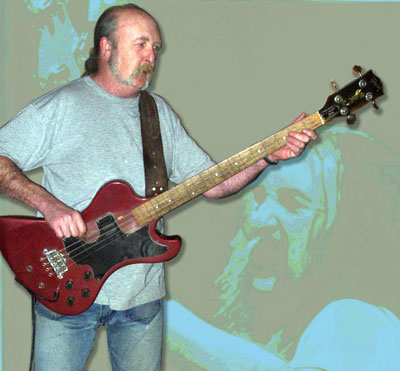
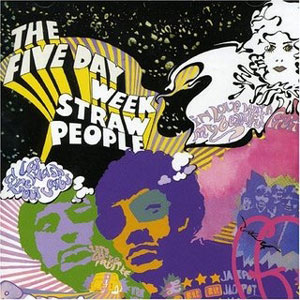
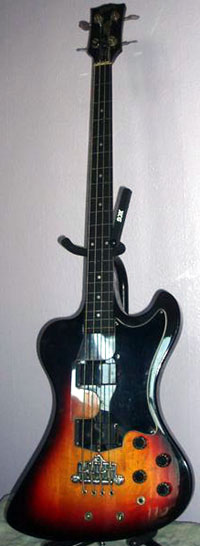
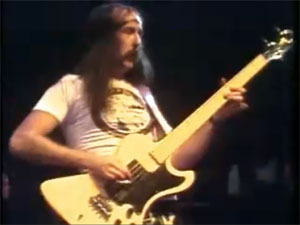 Mick Hawksworth on stage with Alvin Lee, using the RD Artist Bass guitar
Mick Hawksworth on stage with Alvin Lee, using the RD Artist Bass guitar